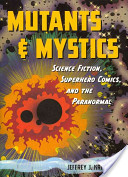Mutants and Mystics: Science Fiction, Superhero Comics, and the Paramormal
 Lately I've been investigating aliens and monsters and no, not due to any premonitions of doom, but because I believe they have something to teach us about ourself, the "other", alienation and our shadows. I'm reading a fascinating new book by Jefferey J. Kripal and here are my favorite bits so far:
Lately I've been investigating aliens and monsters and no, not due to any premonitions of doom, but because I believe they have something to teach us about ourself, the "other", alienation and our shadows. I'm reading a fascinating new book by Jefferey J. Kripal and here are my favorite bits so far:
Favorite bits excerpted from Mutants and Mystics: Science Fiction, Superhero Comics, and the Paramormal
The mythical themes and paranormal currents of popular culture are generally transmitted through two modes intimately working together: words and images...In the spirit of the conclusion of my last book, where I suggested that we think of an "author of the impossible" as someone who can bring online both sides of the brain, I have transmitted my ideas here through one left-brain-dominant mode (writing) and one right-brain-dominant mode (graphic art).
Rene Warcollier (author of Mind to Mind publ. 1948) who was first awakened to the subject (of the secret life of popular culture) by his own telepathic dreams, believed that telepathic communications most likely reveal a from of psychical operation that employs paranormal processes, predates the acquisition of language, and reveals the very "substratum of thought" in what he called "word-pictures." As Warcollier demonstrated through a series of drawings and his own text. condensed, telepathically communicated word-pictures are often creatively expanded on, exaggerated, and added to by the recipient's imagination until they become words and pictures, and finally stories - in essence, minimyths.
In order (for Alan Moore, creator of the self-conscious occult comic, Promethea) to recreate the sefirot or spheres of consciousness in his art, he first attempted to actualize each sphere in himself through a magical practice, an actualization that he then recreated as the comic. It was in this way that the pages of Promethea became "meditational tools" and potential "triggers fro altered states of consciousness," and the comic itself has become a spiritual tool." Reading is magic.
The closer we approach such a prime moment, singularity, or Omega Point, the more we will realize - with John Keel, I would add - that "the vague mythological beings of the past that have focused into the aliens of the present will son become ourselves as we become the very time travelers whose shadows haunt all our history, including the present, In effect, we are haunting ourselves in the present from the past and the future via the ghost and the alien.
Indeed, whatever they are, the visitors are likely "responsible for much paranormal phenomena, ranging from the appearance of gods, angels, fairies, ghosts, and miraculous beings to the landing of UFO's in the backyards of America". They may be extraterrestrials, "managing the evolution of the human mind," or they "may represent the presence of mind on another level of being". The key for (Whitley) Strieber is that we cease being so passive and admit that we do not know what or who the visitors are. In other words, we must stop kneeling before the gods, quit "hiding in our beliefs," and begin actively, even aggressively exploring "a real relationship" with the visitors, whoever or whatever they are. Put a bit differently, we must "demythologize" them and evolve past "the level of superstition and confusion that has in the past blocked us from perceiving the visitors correctly" How, after all, can we recognize ourselves if we keep projecting those selves into what are essentially religious cartoons? When will we realize that we ourselves are our own authors?
Excerpted from Mutants and Mystics: Science Fiction, Superhero Comics, and the Paranormal by Jeffrey J. Kripal
